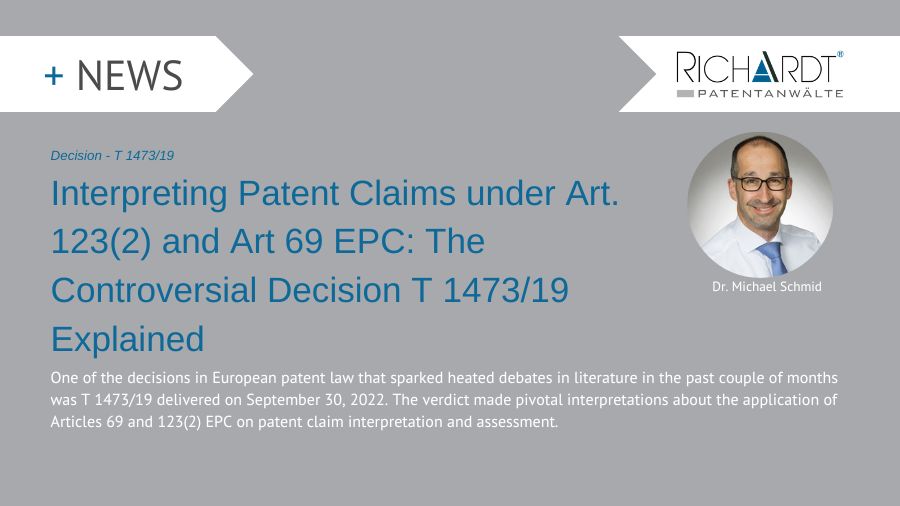One of the decisions in European patent law that sparked heated debates in literature in the past couple of months was T 1473/19 delivered on September 30, 2022. The verdict made pivotal interpretations about the application of Articles 69 and 123(2) EPC on patent claim interpretation and assessment.

The contested patent on which the decision was rendered relates to a contactless rotary joint, where claim 1 recites: “…a rotary joint body (200) of a plastic material, said body having a free inner bore holding a capacitive data link…”. The opponent asserted that claim 1 contains added matter because it requires that the free inner bore holds the capacitive data link, whilst the application as filed only discloses a joint wherein the rotary joint body, not the bore, holds the capacitive data link.
The Board of Appeal noted in it’s decision in Reasons 3.3ff: According to established case law, patent claims must be interpreted through the eyes of the person skilled in the art, who should try with synthetical propensity to arrive at an interpretation of the claim which is technically sensible and takes into account the whole disclosure of the patent. The whole disclosure of the patent includes the description and the drawings, which must therefore be taken into account for claim interpretation. Accordingly, in very many decisions the description and the drawings have been used to interpret the claims and identify their subject. There is, however, also a significant body of case law according to which the description and the drawings should only be used to interpret claim features which are ambiguous; unambiguous terms in the claims should be interpreted without taking the description and the drawings into account.
In an extensive review of previous case law and with reference to national courts of the Contracting States to the EPC and the Unified Patent Court relying on Art. 69 EPC for claim interpretation, the Board came to the conclusion that in serving the legitimate interests of the users of the European patent system “Article 69 EPC in conjunction with Article 1 of the Protocol thereto can and should be relied on when interpreting claims and determining the claimed subject-matter in proceedings before the EPO, including for the purpose of assessing compliance with Article 123(2) EPC” (reasons 3.15 and catchword).
However, while the Board endorsed the necessity of considering the description and drawings in interpreting a patent claim (Article 69(1), second sentence, EPC), it also underlined the primacy (priority) of claims (Article 69(1), first sentence, EPC) in determining the extent of a claim feature's interpretation by the description and drawings. The established case law of the Boards of Appeal that limiting features which are only present in the description but not in the claim cannot be read into a patent claim is thus fully compatible with relying on Article 69 EPC in conjunction with Article 1 of the Protocol as a legal basis for determining a patent claim's subject-matter (Reasons 3.16.1).
In stating and emphasizing the primacy of the claims over the description, the Board of Appeal concluded that this does not exclude a priori that a particular claim feature has a different meaning when interpreted in light of the description and the drawings than when interpreted in isolation. However, according to the Board of Appeal it would be contrary to the principle of priority of the claims if this allowed claim features to be defined at will in the description, even in a way that is not at all compatible with the ordinary meaning of the feature. The priority of the claims therefore also limits the extent to which the description can serve as a dictionary for the terms used in the claims (reasons 3.16.2)
Regarding the contested claim, the Board concluded that the opponent's interpretation was technically reasonable and plausible. However, instead of relying on the principle of the primacy of clear and precise claim features, the Board nevertheless referred to Art. 69 EPC. Here, the interesting assessment was that even if the claim feature is not mentioned as such in the specification, the mere fact that the contested claim feature is not disclosed in the description or drawings according to this understanding does not speak against this interpretation. In other words, as long as the specification does not exclude (for whatever reason) a particular interpretation of the claim feature, the description cannot be used to interpret the claim in a more limiting manner than what is covered by the claim.
Practical implications
The decision's practical implications on the admissibility of applying Art. 69 EPC in assessing an inadmissible extension under Art. 123(2) EPC are open to interpretations. However, if one follows the principles established by the Board of Appeal in the present case, according to which an unambiguous claim wording must be given priority over using the description for claim interpretation, one ends up again at the point of the commonly known (and widely accepted) case law according to which the description and the drawings should only be used for the interpretation of ambiguous claim features; unambiguous terms in the claims should be interpreted without taking into account the description and the drawings.
This ruling might therefore not drastically influence daily EPO application and opposition proceedings as initially perceived, given that it affirms the precedence of clear and concise claim features over the description in claim interpretation. Nevertheless, it reiterates the importance of patent drafting precision and clarifies a certain interrelationship of Articles 69 and 123(2) EPC in claim interpretation.
Talk to us and contact us for further information at:
Phone: +49 (0)611 / 341568-0
Fax: +49 (0)611 / 341568-11
E-mail: Send email to us
PGP-Key
Author: Dr. Michael Schmid
